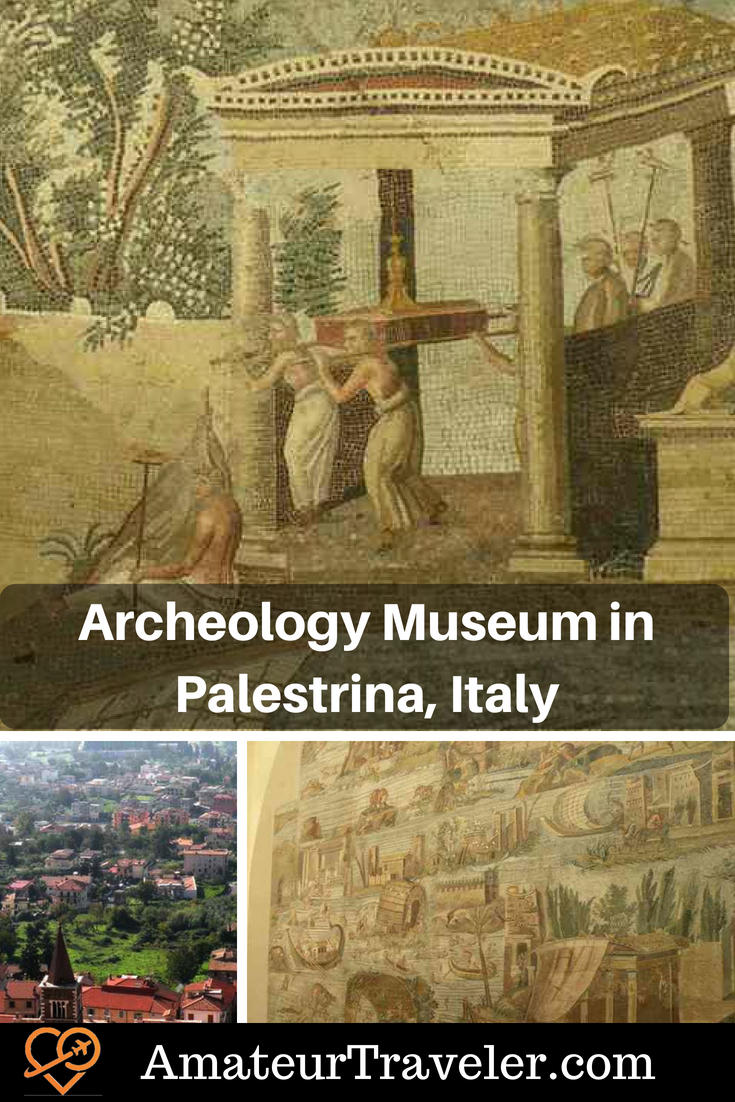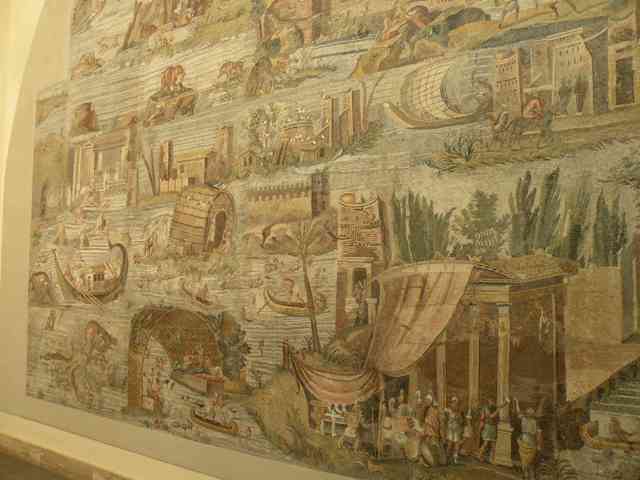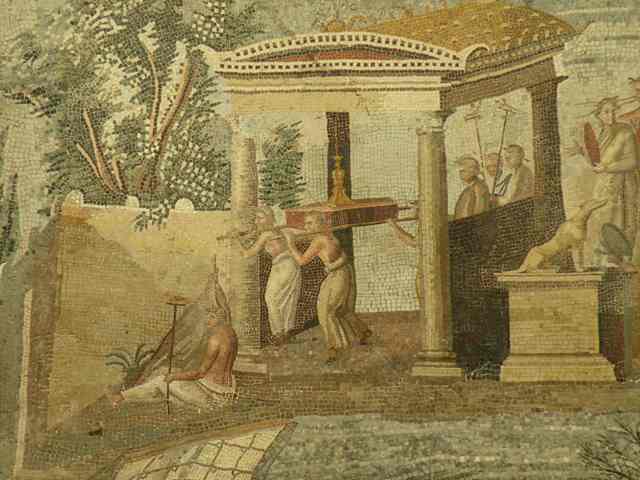If you stood still and listened closely while standing on the mosaic-tiled floor outlined with colorful fish, you might hear future predictions from the mythological orator in the cave of fates or Antro delle Sorti. The grotto structure, likely dedicated to the Egyptian Goddess Isis, was located in what was once a thriving city in Palestrina, Italy. Archeologists have pinpointed the era to 120-80 BC and I saw many artifacts on the original site, stacked  and abandoned in an eerie sense. Greek columns that had held together connecting buildings with an entertaining hall and sanctuary laid in pieces and were strewn about the garden.
and abandoned in an eerie sense. Greek columns that had held together connecting buildings with an entertaining hall and sanctuary laid in pieces and were strewn about the garden.
Palestrina
Palestrina has an intriguing history, situated in a prime location high on a hillside with a cool breeze from the Tyrrhenian Sea. Originally named Praeneste, the name was changed to Palestrina after the famous sacred music composer, Giovanni Palestrina who was born in the town in 1525. Wars with invading armies, emperors and political Popes caused the town to change hands many times over hundreds of years. Destroyed and rebuilt depending who was in power, it has evolved from the Phoenicians, Etruscans and Sulla massacre.
Temple of Fortuna
A stone’s throw away from the grotto, the immense Temple of Fortuna dominated the area as trade built with Greece, Egypt, and Rome. The temple and its terrace houses were discovered after the bombings of World War II. Layers of a community with walkways, coffins, and amber were uncovered and are now presented in the National Archeology Museum, Palestrina which is the former Barberini Colonna palace. When the Italian Government excavated the temple after the war, evidence from the Hellenistic, Imperial and Republican eras were uncovered giving insight into past civilizations.
Clay figurines of human body parts were routinely brought to the temple by those seeking healing and fertility blessings. These objects along with coins from the 2nd century, 7th century hand mirrors, funeral votives, and hand-carved marble statues are on display in the immaculately kept museum. The statues give insight as to who the rulers were. The hairstyles told of their ranking class in society. One of the oldest objects is a headless statue of Goddess Fortuna wearing a gracefully draped and layered gown.
Mosaics
The stunning object which people marvel at in the museum is the extremely large mosaic prominently exhibited on an entire wall, in a room all to itself. Meticulously completed in 2BC, the intricate mosaic had been embedded on the floor in the hall of the forum and has workmanship similar to other mosaic works completed during that time period in Pompeii. Over time, as the area fell into despair, the laborious piece of artwork was removed and placed in a museum in Rome. Eventually, it was brought back to Palestrina and placed on display in the archeology museum.
This 20 foot wide colorful piece follows expressive characters and their society on the upper Nile River and becomes alive with many flowing stories from Ethiopia to Egypt and the Mediterranean Sea. Most likely made by Alexandrian artists, it’s easy to watch ship’s activities with the wide-eyed toll taker, relaxing party with wine and fish swimming nearby, and those casting their nets. Other scenes along the water are a burial ceremony with gold adornments on the hand-carried coffin, animals hunting and battle warriors in headdress and body armor. The style and design of buildings, boats, clothing, and hair changed with the different cultures by using white, brown, and muted green and red-colored tiles. Life, death, celebrations, and taxes are a central theme throughout time. And the aged old mystery with conflicts about the Nile River water usage between Ethiopia and Egypt continues today.
Palestrina Valley
25 miles southeast of Rome, the museum sits high above the lush Palestrina Valley with a stunning view looking onto the valley. No wonder legendary leaders such as Emperor Augustus, Hadrian, and Marcus Aurelius stayed there to get away from daily life in Rome.
The museum is not well known compared to archeology museums in Rome, Athens, and other major cities, but the quiet town of Palestrina and a look at marvelous artifacts is well worth the visit. Transportation from Rome is about an hour on a Cotral bus from Anagnina metro station in Rome, train from Rome to Zagarolo, and then the Cotral bus or highway A24 or A1 if driving.
I’m usually searching for the best gelato in Italy, but this time I found the history of old civilizations well preserved and an explanation to the past.
There are many B&B’s and hotels in Palestrina plus numerous restaurants for a day trip or longer visit.
Museo Archeologico Nazionale Di Palestrina, Italy
- Phone 06.9538100
- 5 euro entrance fee
- Open daily 9 am to 8 pm
- Palestrina Tourism Office 06/95302318
- www.Palestrina.roma.lazio.it
Read more about Italian Travel at www.Italythisway.com




 Athens, Greece, National Museum of Archeology – Video Episode 50
Athens, Greece, National Museum of Archeology – Video Episode 50 Visiting Ostia Antica, Rome’s Ancient Seaport with Context Travel – Italy
Visiting Ostia Antica, Rome’s Ancient Seaport with Context Travel – Italy Travel to Rome, Italy – Episode 29
Travel to Rome, Italy – Episode 29 Top 10 Things to Do When in Rome, Italy
Top 10 Things to Do When in Rome, Italy


Buzz Fere bee
Says:May 11th, 2017 at 1:29 pm
Hello Did they allow photography in the Palestrina museum, without flash ? When I was there a few years ago they did not…but I see your photos of the Nile Mosaic here, very nice. I’d like to go back on my next trip to Rome, but will probably not go again if they are still banning photos.
best regards Buzz